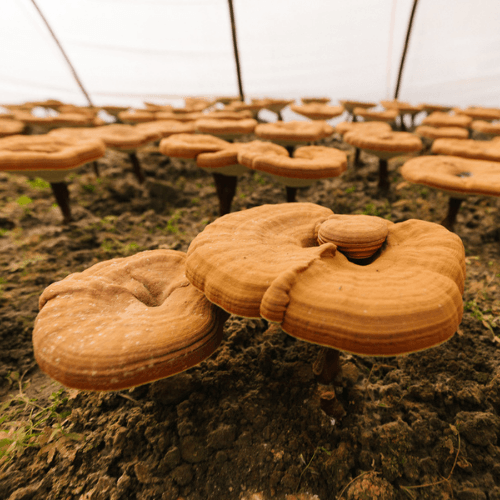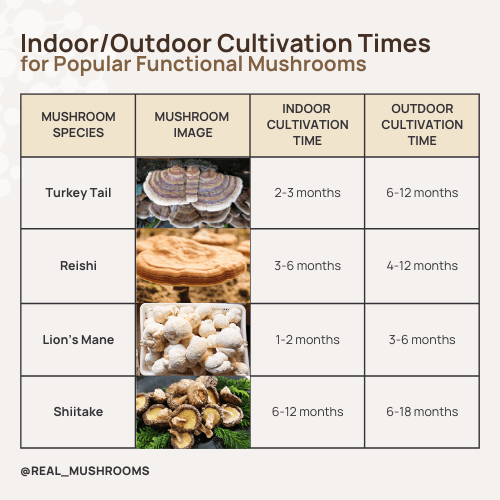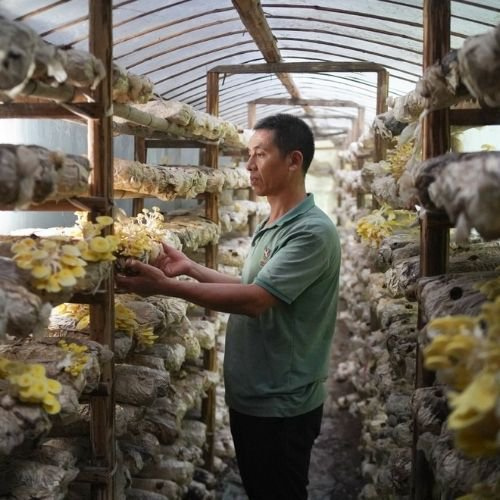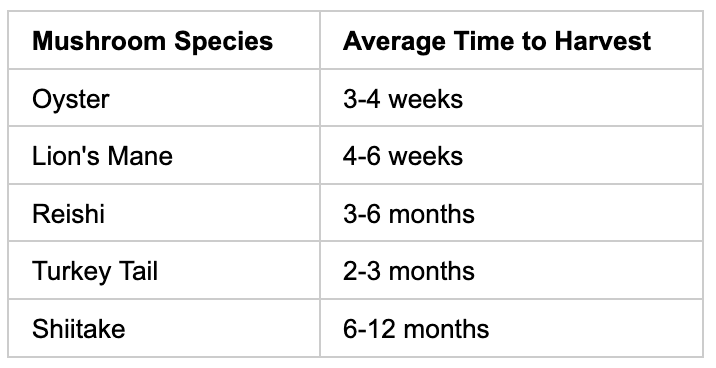Menu




Growing mushrooms can be a rewarding and fascinating journey, but one of the most common questions for beginners is: "How long does it take?"
The truth is, there's no one-size-fits-all answer.
Mushroom cultivation times can vary widely depending on the species, growing method, and environmental conditions.
In this comprehensive guide, we'll break down the factors that influence mushroom growth rates, explore the fastest-growing varieties, and provide practical tips to help you cultivate mushrooms efficiently.
By the end, you'll have a clear picture of what to expect on your mushroom-growing adventure, helping you make informed decisions about which species to cultivate and how to best nurture them from spore to harvest.
Environmental factors play a crucial role in the growth and development of mushrooms (fruiting bodies). Understanding these factors is essential for successful cultivation and optimal harvests.
Temperature, humidity, light, and air quality contribute significantly to the mushroom's life cycle.
Temperature is a key factor in mushroom growth. Most functional mushrooms thrive in temperatures between 55°F and 75°F (13°C to 24°C), though specific requirements vary by species.
For example, oyster mushrooms (Pleurotus ostreatus) generally grow best at temperatures between 25°C and 27°C (77°F to 81°F), while its mycelial growth stage can occur optimally at around 22°C (72°F). [1]
Maintaining consistent temperatures within the optimal range can lead to faster growth and higher yields.
Humidity is equally important for mushroom development. Most species require high humidity levels, typically between 80% and 95%.
Proper moisture balance is crucial; too little can inhibit growth, while excess can lead to contamination. Growers often use humidity controls or misting systems to maintain ideal conditions.
Light, contrary to common belief, does play a role in mushroom growth. While mushrooms don't require light for photosynthesis, many species use light as a trigger for mushroom (fruiting body) formation. [2]
Different wavelengths can affect growth rates and even the nutritional content of some mushrooms.
According to a research study conducted by the Nutrients Journal, UV exposure is shown to increase the vitamin D content in mushrooms. [3]
Air quality and ventilation are often overlooked but are vital for healthy mushroom growth.
Fresh air exchange helps regulate CO2 levels and prevents the buildup of metabolic gases that can inhibit the growth of mushrooms.
Proper air circulation also helps maintain even temperature and humidity distribution.
At Real Mushrooms, we emphasize the cultivation of mushrooms under meticulously controlled conditions that replicate their natural environments.
This focus on environmental factors is crucial for producing high-quality functional mushrooms that exhibit consistent potency and purity.
Functional mushroom cultivation times can vary significantly between indoor and outdoor methods.
Indoor cultivation offers precise control over environmental factors like temperature, humidity, and light, often resulting in faster and more consistent growth. This controlled environment is ideal for mushroom spawn development.
Outdoor cultivation, while subject to natural cycles and beneficial soil microorganisms, is generally less predictable and can lead to longer cultivation times due to seasonal variations.
The choice of organic material used as a substrate can also influence growth rates in both settings.
Here's a comparison of indoor and outdoor cultivation times for some popular functional mushrooms:

Note: These times are approximate and can vary based on specific conditions and techniques.
At Real Mushrooms we primarily use indoor cultivation methods, ensuring consistent quality, year-round production, and precise control over the mushroom's lifecycle.
This approach allows us to maintain our commitment to growing high-quality mushroom extract products that do not contain mycelium or any other fillers.
The focus on indoor cultivation and fruiting bodies ensures that Real Mushrooms' products deliver the full spectrum of beneficial compounds found in mature mushrooms, supporting various aspects of health, including immune function and overall well-being.
Their controlled indoor environment also allows for optimal timing when harvesting mushrooms, ensuring peak potency of beneficial compounds.
Understanding the growth stages of mushrooms is crucial for both novice and experienced cultivators.
The journey from spore to harvest involves several distinct phases, each with its own timeline and requirements. Learning how to grow mushrooms effectively requires attention to each stage.
The first stage, spore germination, typically takes 24 to 48 hours under optimal conditions. During this time, microscopic spores absorb water and nutrients from the growing medium, initiating the growth process.
Temperature and humidity play vital roles in successful germination, with most species preferring warmer temperatures between 21-24°C (70-75°F) and high humidity levels.
Following germination, the mycelium growth stage begins. Depending on the mushroom species and environmental conditions, this phase can last anywhere from 1 to 3 weeks.
This phase involves the mycelium spreading through the fruiting substrate, forming a network of hyphae. The grain spawn becomes fully colonized during this stage, which is critical for establishing a healthy mushroom crop.
At Real Mushrooms, we use only the mushroom (fruiting body) in our mushroom capsules, powders and blends, as the mycelium and substrate can dilute the beneficial compounds found in the fruiting body.
The mushroom formation stage is perhaps the most exciting for cultivators.
This process typically takes 3 to 7 days from the appearance of pins (small, immature mushrooms) to fully developed mushrooms ready for harvest.
Factors such as temperature, humidity control, and light exposure in the grow room can influence the speed and quality of fruiting body development.
It's worth noting that different functional mushroom species may have varying growth timelines.
For example, oyster mushrooms are known for their rapid growth, often ready for harvest within 3-4 weeks from inoculation. In contrast, shiitake mushrooms may take 6-12 months when grown on logs, wood chips, or 2-3 months using sawdust blocks or wood pellets. [4]
Some species may require cooler temperatures during certain stages, while others need the same amount of warmth throughout.
By understanding these growth stages and timelines, including the importance of fruiting substrate preparation, you can better appreciate the complexities of mushroom cultivation and the importance of using high-quality, fruiting body extracts in functional mushroom supplements.

Real Mushrooms’ organic golden oyster mushroom farm, located in the mountain regions of China. These mushrooms are grown on sterilized sawdust logs.
The journey from inoculation to harvest varies significantly among different mushroom species.
For turkey tail mushrooms (Trametes versicolor), the process typically takes 2 to 3 months. However, it's important to note that this timeline can fluctuate based on several factors including:
For example, oyster mushrooms are the fastest growing mushrooms and are often ready for harvest in just 3 to 4 weeks.
On the other hand, shiitake mushrooms (Lentinula edodes) may require 6 to 12 months before the first harvest, depending on the cultivation method.
Here's a general timeline for some popular functional mushrooms:

It's crucial to understand that these timelines refer to the growth of the actual mushroom (fruiting body), not mycelium or spores.
While faster growth might seem desirable, it's essential to consider that some slower-growing species, such as reishi (Ganoderma lucidum), may develop a more concentrated profile of beneficial compounds over time.
This aligns with our commitment to providing high-quality, potent functional mushroom products.
The cultivation process requires patience and attention to detail. Proper environmental control, including temperature, humidity, and air exchange, can help optimize growth rates.
However, it’s important to give your mushrooms some grow room because rushing the process may compromise their nutritional value and potential health benefits.
Mushroom spawn plays an important role in how quickly mushrooms grow. The growing process varies a bit among different species. Here's an overview of some common and functional mushrooms, arranged by their typical cultivation times:
Interestingly, not all mushrooms grow at the same amount of speed, even within the same species. Factors like substrate quality and environmental conditions can influence growth rates.
It's important to note that faster growth doesn't necessarily equate to better quality or higher concentrations of beneficial compounds.
The viability of mushroom spawn can vary greatly depending on storage conditions and species. Typically, mushroom spores can remain viable for several years when stored properly, but their potency may decrease over time.
The longevity of spores depends on various factors, including storage conditions and the specific mushroom species. Different species may have varying spore viability periods, impacting the growing process.
To maximize spore viability, it's essential to store them in a cool, dark, and dry environment. Ideal storage temperatures range from 2°C to 4°C (35°F to 39°F), such as in a refrigerator. [5]
This can extend their viability significantly, often up to 12 months, when kept in a sterilized spore-water solution. [6]
Proper storage can help maintain spore viability for up to five years or more, depending on the species. Different mushroom species exhibit varying spore longevity:
It's important to note that while spores may remain viable for extended periods, their germination rates tend to decrease over time. [7]
For optimal results in cultivation, it's advisable to use fresh spores or those stored for shorter durations.
According to a study by the National Center of Biotechnology Information, maintaining sterile conditions to prevent contamination is crucial when working with spores [7].
This is particularly important for those interested in home cultivation of functional mushrooms for health benefits.
However, for those seeking the advantages of mushrooms without the complexity of cultivation, Real Mushrooms offers different strains of carefully prepared mushroom extract supplements derived from whole mushroom fruiting bodies.
The shelf life of harvested mushrooms varies depending on storage conditions and preservation methods. Fresh mushrooms typically last between 5 to 10 days when stored properly in the refrigerator. [8]
However, at room temperature, their shelf life is significantly shorter, ranging from 1 to 3 days due to rapid deterioration caused by high respiration rates and moisture loss. [7]
To maximize freshness, it's recommended to store mushrooms in a paper bag or breathable container, as plastic can trap moisture and accelerate spoilage.
The shelf life can also vary by species. For instance, button mushrooms typically last 5 to 7 days under refrigeration, while shiitake mushrooms remain fresh for about 3 to 5 days. [9]
Oyster mushrooms have reported shelf lives ranging from 5 to 10 days, depending on conditions.
Several preservation methods can extend the shelf life of mushrooms:
While preserved mushrooms retain many nutritional properties, some compounds may degrade over time. Therefore, it's advisable to consume mushroom products within their recommended shelf life for optimal health benefits.
Growing mushrooms is a rewarding process that varies in duration depending on the species and cultivation method.
While some fast-growing varieties, such as oyster mushrooms, can be ready in just a few weeks, others may take several months to fruit.
Environmental factors, growing techniques, and the specific mushroom strain must be taken into consideration when determining cultivation time.
By understanding these variables, both novice and experienced growers can optimize their cultivation process for better results. Remember, patience is key in mushroom growing, and the wait is often rewarded with delicious, nutritious harvests.
Whether you're cultivating for culinary delight or health benefits, the journey from spore to plate is a fascinating exploration of nature's cycles.
For those seeking a reliable source of high-quality mushroom products without the wait, Real Mushrooms offers a range of carefully cultivated and expertly processed supplements, ensuring you can enjoy the benefits of mushrooms year-round.

 .
.Disclaimer: The information or products mentioned in this article are provided as information resources only, and are not to be used or relied on to diagnose, treat, cure, or prevent any disease. This information does not create any patient-doctor relationship, and should not be used as a substitute for professional diagnosis and treatment. The information is intended for health care professionals only. The statements made in this article have not been evaluated by the Food and Drug Administration. Any products mentioned are not intended to diagnose, treat, cure, or prevent any disease. The information in this article is intended for educational purposes. The information is not intended to replace medical advice offered by licensed medical physicians. Please consult your doctor or health practitioner for any medical advice.